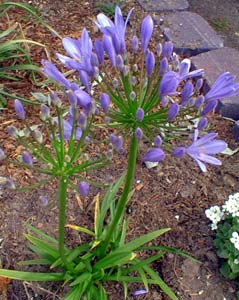
Dwarf Lily of the Nile;
aka, 'Peter Pan' Agapanthus;
aka, Dwarf African Lily
The 'Peter Pan' series of dwarf African lilies (Agapanthus africanus) come in white, pale violet, & deep purply blue. This one is Peter Pan Blue. It blooms May & June, & is capable of blooming until August.
It's was just a small start n 2003, but if it had taken hold & naturalized as is possible, it can potentially become a very flowery clump for years to come. Unfortunately it did not return after a cold wet winter. We may plant it again sometime in the future, though this first disappointment was discouraging.
This native of South Africa ought to adapt to USDA zones 7 through 9. It has glossy grassy leaves eight inches or a foot tall. The blue flowers occur atop upright stems one foot to eighteen inches. This is way less than half the size of the species.
It has low water requirement, thriving on neglect, thus good for containers or roadsides. It dislikes regular watering & requires perfect drainage. In a hotter more arid area it can do well with partial shade, but in our Puget Sound climate, full sun is pretty much required.
Ours was located across the sidewalk on the street's edge along with a red hot poker, a white rock cress, lavenders & sun roses, all of which likewise require no irrigation.
Everything else has done great; why 'Peter Pan' pooped out is hard to guess. An arid environment would be its preference but it is generally adaptable to our area's higher humidity as long as the root doesn't often get soggy.
'Peter Pan' Lily-of-the-Nile is hardy to about ten degrees F. In zone 7 it dies back in winter, in zone 8 it attempts to be evergreen with varying degrees of success or failure, & in zone 9 it is reliably evergreen. As it makes a good container plant it can be grown in colder areas but brought in for the winter, but while it is indoors it may require a daily misting.
If a clump properly perennializes, then every third year or so, it can have its extensive thick root system divided for propagating purposes & to refresh the clump.
See also A. x africanus 'Tinkerbell.'